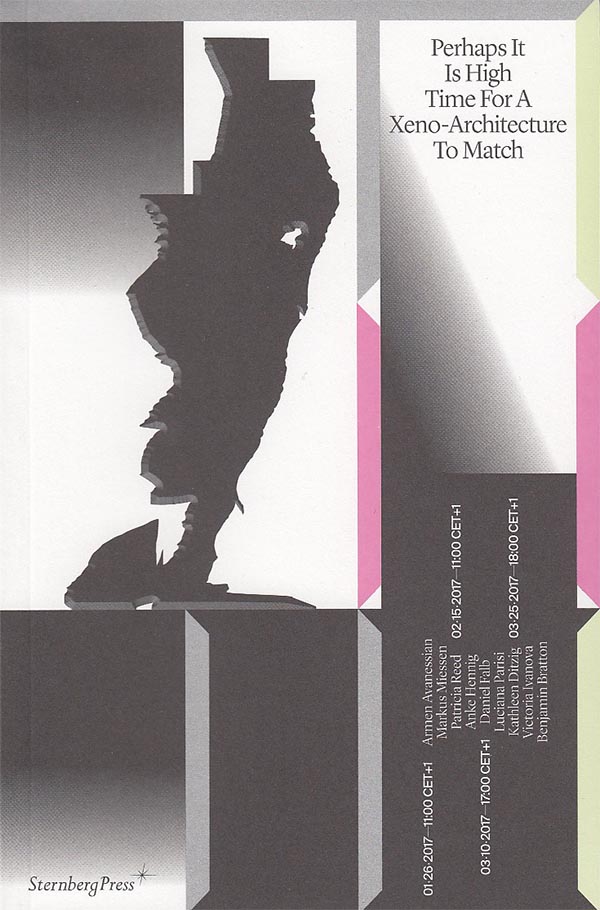Markus Miessen
Markus Miessen

Perhaps It Is High Time for a Xeno-architecture to Match
Armen Avanessian, Lietje Bauwens and 3 more
“Xeno” speaks to the turn away from “what is” toward “what could be”: the (as yet) unknown, the alien—having been employed in recent years through such speculative-political approaches as xenofeminism and xenopoetics. Perhaps It Is High Time for a Xeno-architecture to Match documents a conversation series from January to March 2017 that explored what an intervention of the xeno might bring to bear on contemporary and future (infra)structure.
This book aims to unpack the prefix, probing what it entails—not merely rhetorically but also as a means of practice, in an attempt to bring the ideas it contains more concretely into the domain of architecture. It proposes to link the more philosophical discussions on the notion of xeno with questions of instrumentalization and governance that are necessarily involved in the praxis of architecture. And it relates the significance of legal architecture and technologically driven transformation in the metaphysics of law back to the agenda of xeno-architecture. By researching how architects, artists, thinkers, and activists operating in the spatial field might endorse a process of “alienation” to confront global issues, this project attempts to re-radicalize spatial practice.
Contributions by ARMEN AVANESSIAN, BENJAMIN BRATTON, KATHLEEN DITZIG, DANIEL FALB, ANKE HENNING, VICTORIA IVANOVA, MARKUS MIESSEN, LUCIANA PARISI, PATRICIA REED.
And more

What Makes an Assembly? – Stories, Experiments, and Inquiries
Laurent Jeanpierre, Anne Davidian
A crossdisciplinary inquiry into the practices and forms of assembly making, through multiple times and geographies.
Assemblies are ancestral, transcultural ways of coming together as a community. Over the past decades, multiple social movements have reappropriated these forms of collective organisation as a prominent component of political struggle, to defend radical visions of democracy. At the same time, governments across the globe have sought to reframe public deliberation as a response to the failures of representative democracy.
How can we analyze this double movement, and could assemblies of equals once again offer possibilities to reimagine and renew the ways politics is practiced? To address these questions, we need to move beyond simply asking what assemblies can do, and instead examine how they are made. This means departing from the shores of a speculative, deliberative ideal and restoring attention to both their diversity of forms, and their capacities to perform, deform, and transform.
Bringing together accounts written by those who practice assemblies, and contributions from artists, activists, historians, philosophers, and social scientists, as well as three architectural experiments that attempt to imagine models for a future assembly, the book proposes a critical inquiry into the potential of assemblies to shape political subjects. From assemblies in Indigenous territories of Brazil to those of the Yellow Vests in France, from medieval communes to street parliaments in Africa, from citizens' assemblies set up by public authorities to practices forged from emancipatory traditions, What Makes An Assembly? examines the tensions that exist in all assemblies between the need for form and the danger of formalization; between the scripts, rituals, and architectural settings from which they derive, and their capacity to erupt and emerge anew.
Contributions by Ayreen Anastas, Andreas Angelidakis, Hans Asenbaum, Frédérique Aït-Touati, Richard Banégas, Sandra Benites, Jean Godefroy Bidima, Patrick Boucheron, Florence Brisset-Foucault, Manuel Callahan, François Cooren, Armando Cutolo, Pascale Dufour, Ben Eersels, Tallulah Frappier, Rene Gabri, Delphine Gardey, Alana Gerecke, Andrés Jaque/Office for Political Innovation, Laurent Jeanpierre, Pablo Lafuente, Laura Levin, Stacey Liou, Catherine Malabou, Charlotte Malterre-Barthes, Florian Malzacher, Piersandra Di Matteo, Markus Miessen, raumlabor, Philippe Urfalino, Yellow Vests, Aleksandra Wasilkowska, Ana Terra Yawalapiti.